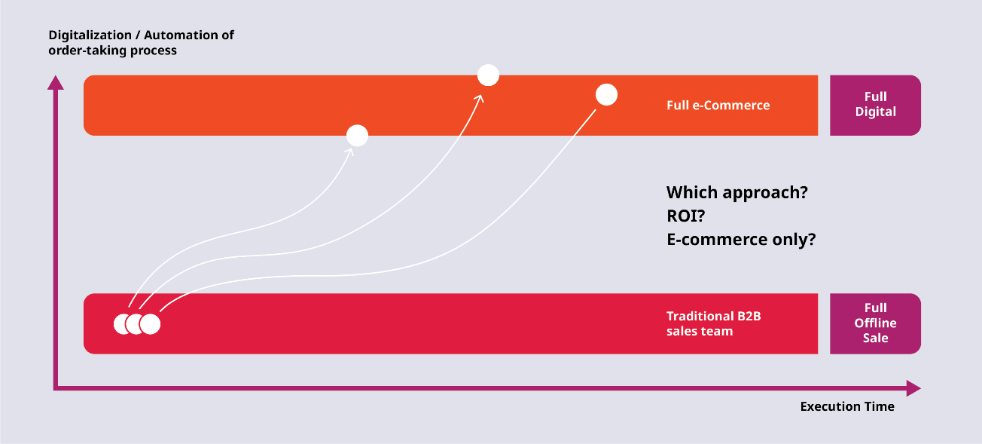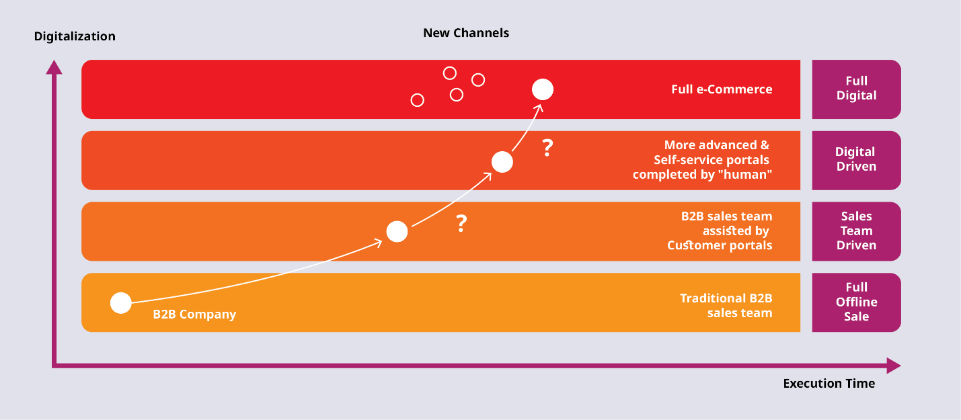Three B2B Strategies to Change Your Way of Selling part one

Transforming Existing Sales Channels - From Engagement to E-commerce
Coronavirus has changed the world. Even after the pandemic subsides, some of the changes will have become permanent. To survive now, and into the future, businesses need to transform their sales models. Today, only 10-12% of B2B transactions happen online with most sales interactions still happening between people, digitalizing these interactions is the next step . In this two-part blog series for leaders in B2B companies, we look at strategies to make that change.
Today, buyers prefer to purchase through digital channels, especially for certain (simple) products and transactions (returns).
Yet companies that have an established and success in-person sales model have been reluctant to change. These businesses are facing the classic innovation dilemma: why change if my sales are still performing well? While they hear from their customers the need to go digital, and now with the extra pressure of changing working practices it is not immediately obvious for them how to incorporate digital selling in their way of doing business. Should they leave their existing sales approach as is albeit embracing more virtual meetings and only look at new digital opportunities? This is probably the most common first thought. Here at Ibexa, we believe that B2B companies need to transform both their current sales approach and explore new digital revenue channels.
Transforming Traditional Sales Channels
How can businesses transform their traditional sales channels, the ones that they have utilized the most in the past, the ones driving most of their revenue? This is obviously a challenging process and many B2B companies do not fully understand how to attack this: How should they approach such a transformation? And how fast? Many read about e-commerce, is that the right way to go for them? As mentioned in my recent blog post (Inventing the Disruption of Tomorrow), this transformation question does not have to be answered by only implementing an online store.
Figure 1. How to proceed? How fast?
Where to Begin
At Ibexa, we think that there is a more progressive approach where the key is in the ability to convert sales engagement into digital engagement, to transition from human to digital interactions. Here are three strategies to successful digital selling transformation (see picture below):
- Sales-team driven with online alignment: This is the lowest hanging fruit for B2B companies who are still delivering through traditional channels (e.g. face-to-face [today mainly virtual] meetings and [online] trade shows ) and are only just waking up to change as sales performance and pipeline development are still good despite the new normal of lockdowns and less personal contact. These companies need to maintain strong relationships with their clients and partners while investing in a more digital future with them. The simplest way to do this is the implementation of customer portals (both for existing customers and prospects) in the broadest sense. These portals enable B2B companies to share account-specific information (sales material, order history, invoices, billing information, etc.) with their prospective and existing clients, dealers, resellers, or distributors. It also lets them identify their customers online, and easily personalize their online content to them. This both creates visibility in the business relationship and helps the sales team to better engage with their end users. The relation is still strongly between the buyer and a human – the account exec, with digital processes facilitating their job.
- Online driven with sales team support: The second strategy to transform traditional selling into digital is to implement more advanced and self-service portals for B2B buyers. These customer portals go beyond information sharing as in the first step. They enable customers, dealers or partners to take specific actions in their buying process such as selecting products or services, calculating prices, requesting quotes or any action that would help them to decide. These self-service functions are expected by today’s (digital) buyers. In addition, these portals are great complementary tools for sales teams who can deliver more value and complete the order process faster. The relation is between the buyer and the brand, where the sales exec plays a complementary role and is fairly interchangeable.
- Full e-commerce (B2B and B2B2C): The third strategy is the complete digitalization of the sales process. Here, human interaction is minimized, and automation maximized. The customer portals from the two first phases have evolved into full B2B shops integrated with PIMs, ERPs and CRMs. Catalogs are fully digitalized, and customers go through the whole cycle – getting quotes, negotiating, and completing their orders (and re-orders) online. This fully digital stage offers opportunities for up- and cross-selling with intelligent recommendations and a greater level of personalization.
Figure 2. Which strategy and how fast?
Outcomes
The three strategies presented above can be adopted to stay relevant and address the expectations of today’s B2B buyers . Obviously, the speed of transformation attached to these three approaches varies and is more or well-suited depending on the context and the situation for an individual business. But the outcomes of removing inefficiencies out of the human process are what’s crucial, digital transformation reduces buyer friction resulting in shorter sales cycles; it increases the pipeline and also it’s scalable, facilitating a greater number of transactions, all of which lead to the most desired outcome of higher revenue.
In my second blog post, I’ll look at specific characteristics to consider and key questions that need to be asked to select and define the best approach to digital transformation: sales performance, digital maturity and business complexity.
In the meantime, why not download our most recent eBook: The Three Pillars of Successful B2B Digital Transformation , where we reveal we reveal how B2Bs can successfully respond to change and invent the disruption of tomorrow.
Businesses need DXPs to respond to change, and to invent the disruption of tomorrow
The Three Pillars of Successful B2B Digital Transformation
B2Bs have to be bold and inventive to disrupt their own business models, read how to be successful in our eBook. If you are struggling with your B2B digital transformation efforts, why not reach out to us to discuss your project.



